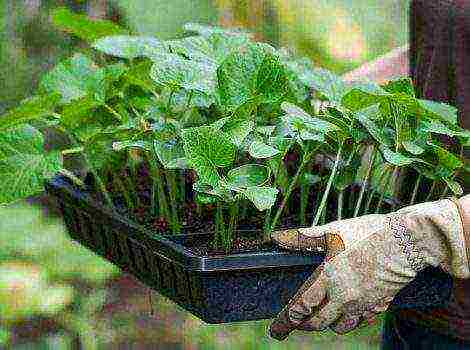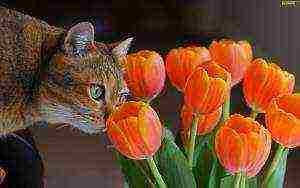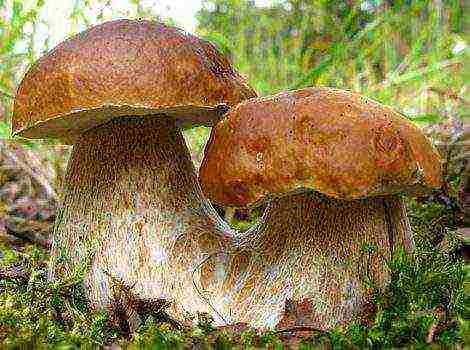Content
- 1 Stump breeding technology
- 2 Growing technology in glass jars
- 3 Cellar growing technology
- 4 Flammulina description
- 5 Substrate preparation
- 6 Sowing mycelium
- 7 Mycelium germination conditions
- 8 Growing honey agarics in stumps and on logs
- 9 Output
- 10 In what conditions do mushrooms grow
- 11 Methods for growing honey agarics at their summer cottage
- 12 Why honey mushrooms
- 13 Where to germinate in the garden
- 14 The choice of material for planting
- 15 Preparation and landing
- 16 Germination in bags
- 17 How to grow honey mushrooms in the country from mycelium
- 18 Method three
- 19 Germination of mycelium
- 20 Growing features

Summer and winter mushrooms can be easily grown on their own. Planting mycelium (mycelium) is bought both in specialized stores and on the Internet.
Usually, for breeding at home, a winter type of edible mushroom is chosen, the so-called flammulina. The most common are three simple growing methods, technologically different from each other: on stumps or logs, in banks, in the basement.
Stump breeding technology
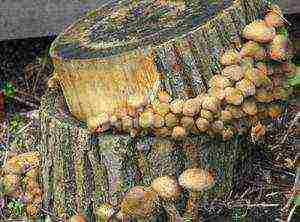
Growing honey agarics on stumps
In this case, a remarkable positive difference is that it does not require large financial investments and affordable ease of execution for anyone.
Planting honey agaric on stumps (logs) in the open field in the garden or in the country is most favorable in the warm season from April to September inclusive, indoors, if logs are used, - mushroom mycelium can be planted year-round.
For planting honey agarics in the country, you should choose a shaded place. Otherwise, they will need to be covered with straw or hay. Only deciduous tree stumps are used: aspen, birch, poplar, hornbeam, beech, apple, acacia, pear.
It is important that the tree is felled at least one month before the start of work. Also, there should be no signs of rotting, they should be sufficiently moist, with bark, but without branches. If the stumps are dry, then they must be thoroughly soaked in water for 2-3 days.
Allow excess water to drain for several days and ventilate in partial shade. Then, in a checkerboard pattern, using a drill, holes are made over the entire surface of the stump with a depth of 5-6 cm and a diameter of 0.8-1 cm. Small pieces of mushroom mycelium will be planted in these recesses.
They cover themselves with moss or branches. Periodically, in order to avoid drying out the stump, the ground around it needs to be watered. With this method, the mycelium grows slowly, therefore, to stimulate growth, it is recommended to cover them with a greenhouse film, which is nailed down with small nails for fixation.
Good to know: mushrooms love to grow only on dead wood; for garden trees, growing honey agaric in the country is absolutely harmless.
The result is expected the next year at the beginning of summer and then you can collect honey mushrooms regularly for 5-7 years until the stump or log is completely destroyed. At first, the mushroom harvest will be small, but gradually it increases by 2-4 times.
Growing technology in glass jars
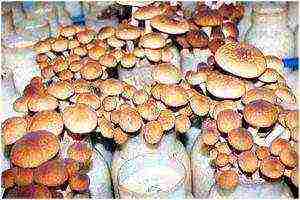
Growing honey agarics in banks
The method is perfect even for city apartments. For the base you will need: 1 part of bran and 3 parts of sawdust of exclusively deciduous trees. But other combinations are possible one by one:
- sawdust;
- buckwheat husk;
- sunflower husk;
- chopped ears of corn.
Husks and cobs are allowed to be used as an independent base. Boil everything together in water. When the sawdust drains a little and cools down, add nutritious mass to enhance the growth of mushrooms in the jar. For 1 kg of sawdust you need to take:
- 8 gr. starch;
- 25 gr. oat flour;
- 25 gr. corn flour.
Then the jars are tightly filled with the resulting mass by 2/3 of the volume, sterilized in a large saucepan over low heat for at least 2 hours. After cooling to 25 ° C, depressions of 5-7 cm are made with a sterile stick and mycelium is added. After the cans are placed in a dark place with a constant temperature of 24 ° C and 85% humidity.
To avoid drying out, the contents are covered with a lid with a hole, which is covered with cotton wool. When the mycelium sprouts, the jars are moved to a cooler place or the temperature in the room is lowered to 14-16 ° C. On the neck of the jar, paper is attached in the form of a cuff and wait for the appearance of the crop.
Take a note: planting material must be of high quality and sterile. It is produced under special conditions and packed in breathable bags with a biofilter.
When the mushrooms sprout 5-7 cm from the jar, the cuffs are removed and the mushrooms are cut off. The yield is 25-30 percent of the initial volume of the wet substrate.
The containers are closed again and left on the glazed balcony. In 20-30 days, you can expect new honey agarics.
Cellar growing technology
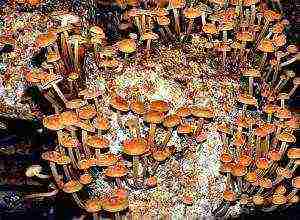
Growing honey agarics in the basement
For the third method of growing mushrooms at home, use a basement. The room must be prepared in advance. Whitewash or treat with 4% formalin solution to prevent insects and mold.
Provide forced ventilation with a power of about 25 kW or make ventilation outlets to the surface.
If mushrooms are grown in the basement all year round, then a heater must be provided to maintain an optimal temperature of 24-26 ° C. For the substrate mixture, you can choose:
- chopped straw;
- sawdust;
- foliage of trees;
- husk from seeds.
Steam the substrate with boiling water for 6-12 hours and after cooling, mix with 300 g of fine mycelium. Arrange in dense plastic bags of 5-15 kg, tie them and lower them into the basement. After 3 days, you need to make several holes of 4-6 cm in the bags or completely remove the bag from the substrate.
On the 12-16th day, the sprouted fruiting bodies of the mushrooms will be visible. Now they need to provide sufficient access to light and reduce the temperature to 14-16 ° C. On such a home mini-farm, subject to the technology, in 1.5-2 months it is possible to collect up to 20 kg of mushrooms from one square meter.
Note: the room where mushrooms are grown must be well ventilated and at the same time a constant temperature and humidity must be maintained.
How to grow honey agarics at home, see the following video:
Rate the article
(
estimates, average:
out of 5)
For growing mushrooms at home, it is preferable to choose a winter species - flammulina. It is adapted to the conditions of a house or apartment, undemanding to lighting. Just like other mushrooms, it prefers high humidity and low temperatures.
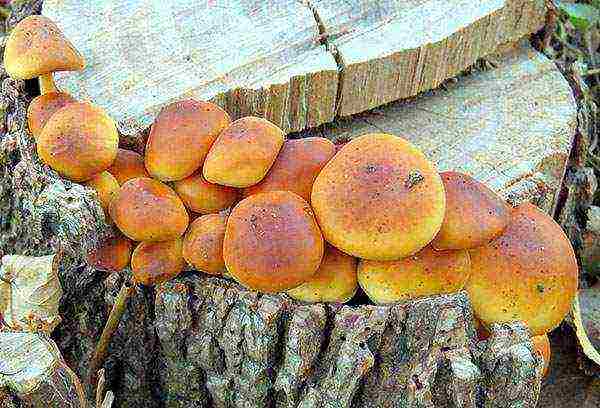
Flammulina description
Suitable conditions can be created in the basement, in the insulated attic, on the glassed-in loggia or in the garage. In a small amount, it is possible to grow winter honeydew on the windowsill.
The color of the cap depends on the brightness of the light. The brighter the illumination, the brighter the color. With a lack of light, the mushrooms do not stain, remain white, but at the same time, taste and useful properties are not lost.
Flammulina differs from other species in that not only hats, but also velvety legs are eaten. The lower part is removed, leaving a length of about 4-7 cm. The leg has a delicate texture, and the taste does not differ from the cap.
These mushrooms contain a small amount of weak toxic substances, so it is undesirable to eat them raw. The recommended cooking time is 20-25 minutes, after which the toxins are completely destroyed.
Cut mushrooms are stored in the refrigerator for 5-6 days. They can be fried, pickled and dried. After heat treatment, they do not lose their nutritional and taste qualities.
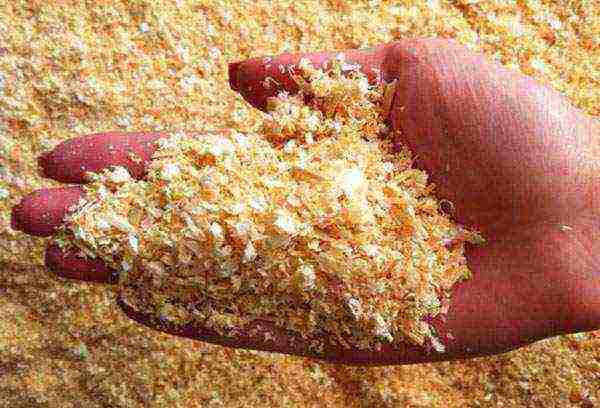
Substrate preparation
For sowing the mycelium, you can buy a ready-made block in a specialized shopping center, or you can prepare the substrate yourself.
You will need:
- sawdust or shavings from deciduous trees - 3 parts (can be replaced with deciduous litter or straw, oak and conifers are not suitable for growing mushrooms);
- oats, barley, barley, bran or chopped corn cobs - 1 part;
- chalk or lime at the rate of 1 teaspoon per 300 g of substrate;
- starch, corn or oat flour - 1 tablespoon per 300 g of the mixture, it is necessary to enhance the nutritional properties.
The resulting mixture is thoroughly mixed, poured with warm water for swelling, and left for 10 minutes. Then boil over low heat for 40-50 minutes to destroy the spores of other fungi and pathogens of fungal infections. To avoid burning, water is added little by little.
After the end of cooking, the water is drained, the substrate is left on fire to evaporate excess liquid. The finished mixture should be wet, but not wet.
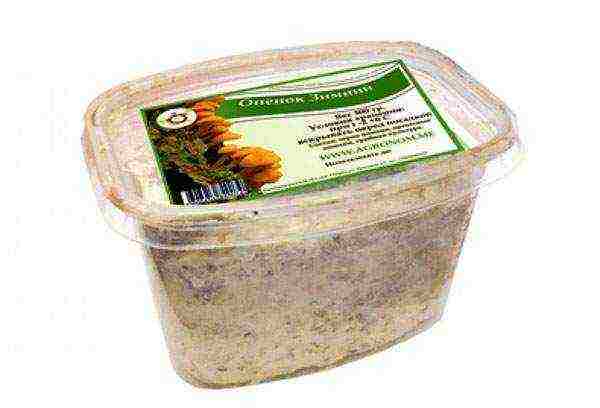
Sowing mycelium
One- and two-liter jars or durable plastic bags with a volume of at least 2 liters are suitable for growing honey mushrooms. The resulting mixture is filled into a container by 2/3 of its volume.
With a disinfected stick, holes 5 cm deep and no more than 1 in diameter are made in the substrate. It is not difficult to calculate the required amount of mycelium - it should be 2-7% of the mixture mass.
The holes made are filled with mycelium. The temperature of the mixture at this moment should be 25 °.
Another way is when the substrate has cooled to 25 °, the mycelium is added to it and gently mixed with a sterilized wooden spatula. After that, the containers are filled.
Banks are closed with polyethylene lids, in which a hole with a diameter of 1 cm is pre-made. Gases released by the spores of the fungus will escape through the hole. In order to prevent moisture evaporation, the hole is covered with a cotton plug.
Advice
The cotton plug should not fit very tightly into the hole or be tight. It should be slightly fluffed up.
When growing flammulina in bags, they must be tied, leaving a small hole. It is also closed with a stopper.
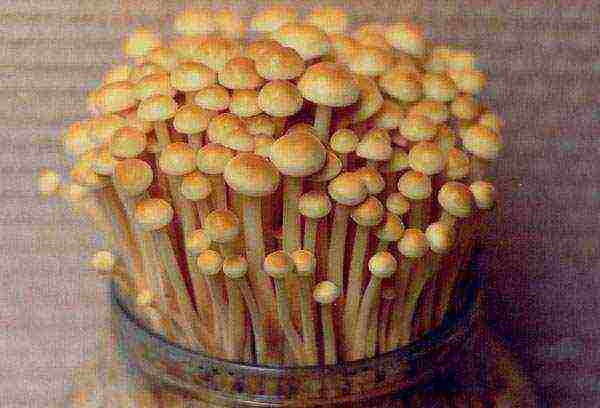
Mycelium germination conditions
The container is placed in a dark place where the temperature is maintained at about 25 °. After 2-3 weeks, the mycelium will germinate and fruit bodies will form on it.
The jar is transferred to a brighter place, the air temperature should be about 15 °. It can be a window on the north side, a glazed loggia.
The lid is removed from the can, the package is untied. Moisture is maintained by regularly spraying the caps and the substrate. If honey-colored drops appear on the caps, then the watering is excessive. The presence of a white coating indicates that there is not enough moisture.
If it is planned to grow winter mushrooms in a basement or garage, their walls are first whitewashed with lime or treated with formalin for disinfection. The room must be equipped with forced ventilation and an air heater.
When the caps appear over the container, a ring of thick paper is put on the neck. This prevents the mushrooms from decaying and allows them to grow up as high as possible.
The ripening period of mushrooms is 45 days from the moment of sowing the mycelium. Cut off the mushrooms at the neck of the jar. The legs remaining inside are carefully removed, and the substrate is moistened and again covered with a lid. New mushrooms will grow in 3 weeks.
In one container, you can harvest 3-4 times, in the future the mixture is depleted, and it should be replaced.
Advice
For continuous harvesting, the mycelium should be populated in separate containers at intervals of 10 days. Then the mushrooms can be cut much more often.
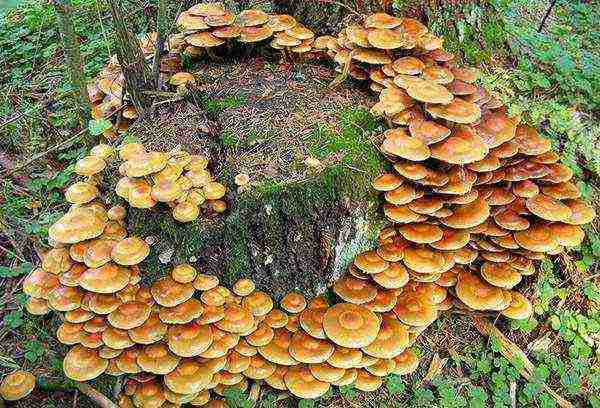
Growing honey agarics in stumps and on logs
The method of growing mushrooms in stumps is used in the garden. It is recommended to populate the mycelium of summer mushroom species.
A stump from a hardwood tree is suitable. You can use a log or log. It should be cut down in 2-3 months and dry out a little.It is necessary to check that there is no mold and other fungi; honey agarics are not bred on diseased stumps.
You cannot place mycelium on living trees, this will lead to the death of the tree.
Several holes 5 cm deep and about 1.5 cm in diameter are drilled in the stump. Pieces of mycelium are carefully placed in them. You can grind it beforehand and mix it with wet sawdust. From above, the holes are covered with moss or hay.
If a log is used, then cuts are made on it up to 6 cm deep, observing the distance between them 15–20 cm. They are laid lying down, burying 1/5 into the ground.
The place for growing honey agaric should be shady and not flooded. Care consists in constant watering. To retain moisture, the stump or log can be covered with cellophane and secured so that the wind does not blow away. For the winter, the film is removed, and instead of it, a shelter is made of coniferous spruce branches, leaf litter or white agrofibre.
Honey mushrooms grown on stumps will be ready for harvest in 2 years. The duration of fruiting is about 5-6 years. After this time, the stump usually decays.
Output
When growing honey agarics at home, you should adhere to the recommendations:
- the growing temperature is not higher than 15 ° (a low temperature for flammulina is not terrible, but its growth slows down);
- a prerequisite - high humidity, from 85%;
- it is necessary to sterilize jars and substrate, otherwise inedible mushrooms may grow instead of honey agaric or mold will appear;
- tools (wooden peg, spoon, knife) must be decontaminated;
- it is not recommended to eat flammulins raw, the minimum cooking time is 20 minutes.
Compliance with these rules is a prerequisite for growing winter mushrooms at home.
Honey mushrooms are one of the most popular mushrooms, since they can not only be collected in the forest, but also grown independently in your country house or balcony. Summer and winter varieties of honey agaric are best suited for breeding at home. They are not whimsical and do not require much effort, even for a beginner.
In what conditions do mushrooms grow
It is easy to arrange conditions for the growth of honey agarics both at home and in a summer cottage or garden. The best time for planting planting material outdoors is in April-May or August., and in the house (warm balcony, basement) throughout the year.
 Honey mushrooms are considered the most delicious and aromatic mushrooms
Honey mushrooms are considered the most delicious and aromatic mushrooms
The air temperature at different stages of growth should be from +10 to + 25 ° С.
With a uniform and high level of humidity, the mycelium develops rapidly, which has a beneficial effect on the growth of mushrooms. The building must be well ventilated, it can be a window or built-in ventilation. Light for the growth of mushrooms is not needed bright, it can be grown almost in semi-darkness. Only then will the mushroom caps be pale, but this will not affect their taste. At the dacha for planting honey agarics, it is better to choose a shady place so that the wood on which the mycelium is located does not dry out.
Methods for growing honey agarics at their summer cottage
You can grow mushrooms using the following methods:
- in the basement on bags;
- on logs;
- in greenhouses;
- in banks;
- on the stump.
In the basement on the bags
The room must be disinfected before planting. The basement should be well ventilated all year round. It needs to be heated in winter.
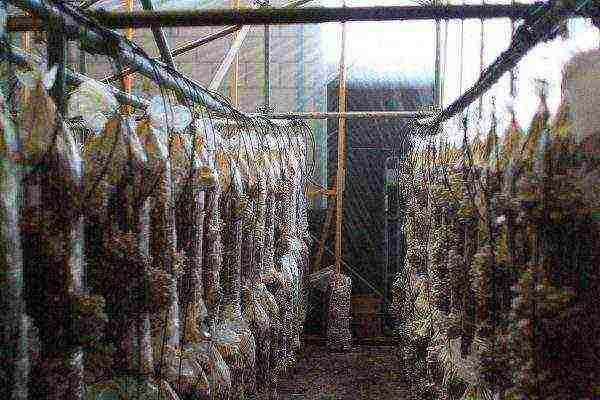 Growing honey agarics in bags
Growing honey agarics in bags
For soil for sowing mycelium, use:
- shredded straw;
- foliage trees;
- woody sawdust;
- husk seeds;
- ready-made blocks substrate.
All plant components are steamed with hot water for 12 hours for disinfection from pests and mold. After cooling, add honey agaric mycelium (according to the manufacturer's instructions) and mix thoroughly. Then the mixture is laid out in dense polyethylene bags from 5 to 50 kg. Tied bags are stacked on shelves or hung in the basement.
After three days, holes about 5-6 cm long are cut in the bags. After 14-20 days, the mushrooms will sprout and become noticeable.
For normal growth of honey agarics at this stage, good lighting, high humidity and temperatures from +14 to +16 ° C are necessary.
On the logs
They can be used to grow mushrooms both on the street and in the house at temperatures from +10 to + 25 ° С. The larch log should not be rotten, but moist and barked. Length 300-500 mm, diameter 200-500 mm. If it is dry, then it is soaked in water for two or three days. Then they are pulled out and allowed to drain off the water.
 Preparation of logs for growing honey agarics
Preparation of logs for growing honey agarics
You can grow mushrooms on logs in three ways:
- Holes are made in the logs 1 cm in size, 4 cm long and at a distance of 10-12 cm from each other. Mycelium on wood sticks is inserted into them. At the same time, hands must be absolutely clean. After that, the logs are wrapped with plastic wrap, making several holes in it so that air can pass inward. Then they are transferred to a damp, darkened room. At 20 ° C the log will be overgrown with honey agaric mycelium within 3-4 months.
- In the infield on the shady side dig a hole 15 cm deep and water it. Then wood is placed in it with a mushroom stick in a horizontal position. The soil around the planting is sprinkled with wood ash to scare away the snails. Watering is carried out regularly so that the earth does not dry out. Cover with leaves for the winter.
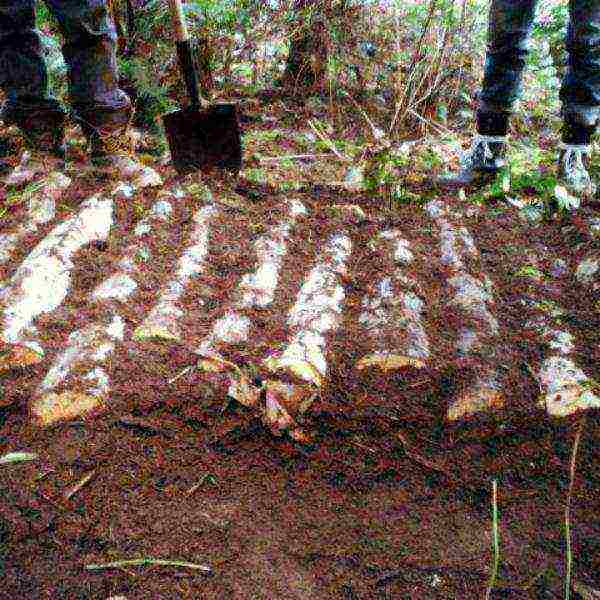 Growing honey agarics on logs
Growing honey agarics on logs
- You can also prepare a prepared log put in a tub or barrel with soil, and put on the balcony. For normal growth, you need to constantly maintain a temperature from +10 to + 25 ° C and high humidity.
A hygrometer is used to determine the percentage of moisture.
In the greenhouse
Greenhouses and greenhouses are well suited for the temperature and humidity levels for growing mushrooms. Logs, stumps, logs are moistened and placed in a greenhouse. After that, holes are made in the wood and myceliums are laid, or they can be poured with a solution containing fungal spores. The planting is watered regularly to maintain moisture, and also monitor the air temperature. It is also possible to grow mushrooms in greenhouses in jars, bags or on substrate blocks.
In banks
This method of growing mushrooms allows you to do without personal plots. The jar can be placed on the balcony or on the windowsill.
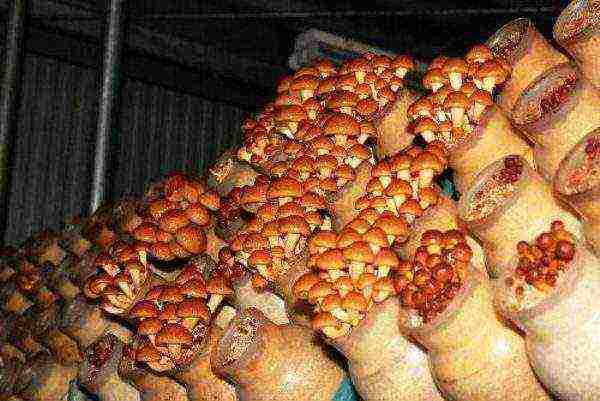 Growing honey agarics in banks
Growing honey agarics in banks
A substrate is made for the growth of the mycelium - a mixture of sawdust (better than larch species) and bran in a ratio of 3: 1. For one day, it is poured with water, then squeezed out and not strongly compacted.
To prevent infection of mycelium with mold, the jar with the substrate is sterilized in hot water for an hour.
After the mixture has cooled, a hollow is made in it with a clean stick to the bottom of the jar and the mushroom mycelium is placed. The container is closed with a lid with holes and covered with wet cotton wool to maintain moisture. The jar is removed to a dark and warm place. As it dries, the cotton wool is moistened.
The mycelium will sprout in a month, and after 15-20 days the first mushrooms will appear. As soon as the mushrooms rise, the container is placed on the windowsill on the north side, or darkened from the sun. When they grow to the lid, it is removed and the neck of the can is wrapped with a wide strip of cardboard. This will help the mushrooms to hold on during growth. To maintain moisture, the mushrooms are sprayed with water. As it grows, the crop is cut off, and the remaining legs are pulled out. In 14-20 days, new mushrooms will grow.
Growing on a tree stump
Planting mycelium on a stump is done in a warm, but not hot season. In the forest, on old stumps or tree trunks, they find mycelium and separate its part along with a piece of wood. For planting, recesses are cut out in the hemp, and pieces of mycelium 1-2 cm in size are laid. Then cover with wet moss or sawdust. The soil around it is watered, preventing it from drying out.
Disputed breeding method
Overripe mushroom caps with a dark brown color underneath are selected. They are placed in a container and filled with clean water for 24 hours. Then, without getting them out of the water, rub them with your hands. The resulting mass is filtered. A solution containing spores is watered on stumps or logs with notches made in them. Thanks to them, the wood is better impregnated. Then they are covered with wet moss or sawdust. Spores germinate for a long time, mushrooms will grow only after 1-2 years. After the mycelium has grown on wood or hemp, it can be propagated. For this, a part of it is carefully separated and transplanted to a new place.
 Honey mushroom mycelium
Honey mushroom mycelium
You need to buy mycelium only in specialized stores, since the goods are stored in them in the correct conditions. If, during the cultivation of winter mushrooms in containers, the temperature rises high, then they should be refrigerated for several days. The temperature should be no more than + 8 ° С, but not less than + 4 ° С.
Many mushroom lovers try to grow mushrooms at home. Not everyone succeeds. So, how to grow honey mushrooms in the country? It is recommended to start planting by choosing a site and preparing it. Such mushrooms grow best on dead wood. However, if desired, you can use a special substrate.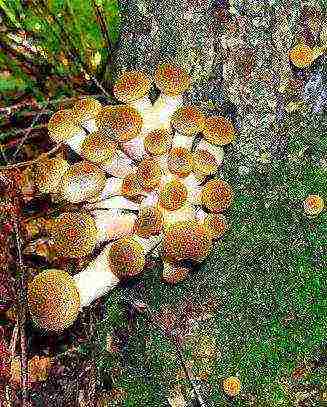
Why honey mushrooms
Honey mushrooms are quite tasty mushrooms that can be grown not only in the summer cottage, but also on the balcony. The main thing is to follow the germination and planting technology. These mushrooms have a delicate and aromatic pulp. Honey mushrooms are often used for making soups, stews and various sauces. After all, the product retains its unique aroma even after heat treatment.
In addition, growing honey agaric is an occupation that can bring a good income. In Slovakia, the Czech Republic and Germany, they are quite often engaged in such a business. However, in these countries, a special paste is used as planting material. It is not yet possible to purchase such a substance in our stores.
Where to germinate in the garden
Since it is not so easy to grow mushrooms in the country, it is worth preparing a place in advance. For germination, stumps from old fruit trees or damp chocks that were lying under a stack of firewood and in contact with the ground are ideal.
If there is nothing suitable on the site, then rotten, rotten boards will do. Also, some summer residents practice growing mushrooms on sawdust.
The choice of material for planting
Growing honey agaric on stumps is a simple process, but a long one. The main thing is to choose the right type of wood. Best of all, summer mushrooms germinate on birch stumps. This material retains a large amount of moisture even after felling. At the same time, the dense bark protects the wood from drying out.
If the mushrooms are planted in the garden, then it is worth using the stumps of old pears and apple trees for these purposes. Honey mushrooms also grow well on alder, aspen and poplar chocks. It is worth considering that mushrooms are capable of destroying any stump in 6 years.
Do not use pine and spruce for growing this type of mushroom.
Preparation and landing
How to grow mushrooms in the country? First you need to infect the old tree stump with the spores of the fungus. This is not difficult. This will require the caps of already adult mushrooms. They must be laid out with the plates facing down on a blank sheet of paper. Spores should spill out of the caps. They look like dark dust. It is recommended to pour spores into a bottle of water and shake well.
It is also worth preparing the stump itself in advance. It is worth sawing off round timber from it, the thickness of which should be from 3 to 5 centimeters. After that, the upper part of the stump must be cut crosswise. This can be done with an ax. The more cracks are formed, the better.
Now it remains to infect the stump with spores. This is done quite simply. It is necessary to water the prepared wood with water, which contains honey agaric spores. After that, it is worth nailing the round timber from above, which was sawn off from the stump.
If the weather is dry, it is advisable to regularly water wood that is contaminated with spores. Otherwise, honey mushrooms will not sprout.
Germination in bags
Since not everyone is able to grow mushrooms in the country in the first way, it is worth thinking about their germination in a greenhouse. To do this, half-rotted pieces of wood should be placed in the corner of the structure. They also need to be watered with water, which contains honey agaric spores. After some time, the wood should be transferred to bags and placed in a dark place in a woodpile. In the spring, the ends, as well as those places where the bark has been damaged, should be covered with mycelium. The material is ready for planting.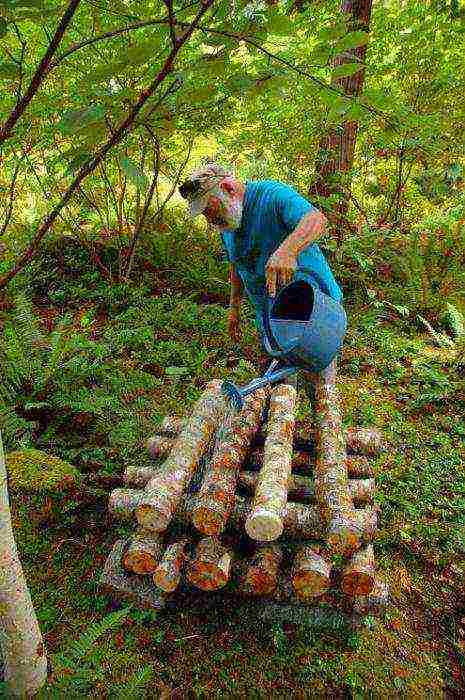
How to grow honey mushrooms in the country from mycelium
The wood on which the mycelium appeared must be placed in the place where the honey agarics are planned to be planted. It should be well protected from wind and direct sunlight. In this way, winter and summer honey agaric is germinated. The mycelium of the fungus must penetrate the soil. From there, it will receive additional moisture. Therefore, it is recommended to dig the chocks with mycelium into the soil by 2/3 of the height. The distance between pieces of wood should be between 10 and 15 centimeters.
In order for a winter or summer honey fungus to germinate, it is necessary to regularly water the chocks. This is especially true in dry and hot weather. It is recommended to water the workpieces for 5 minutes once an hour. At the same time, it is necessary to moisten the wood from 12 to 17 o'clock in the afternoon. By nightfall, the chocks should dry out well.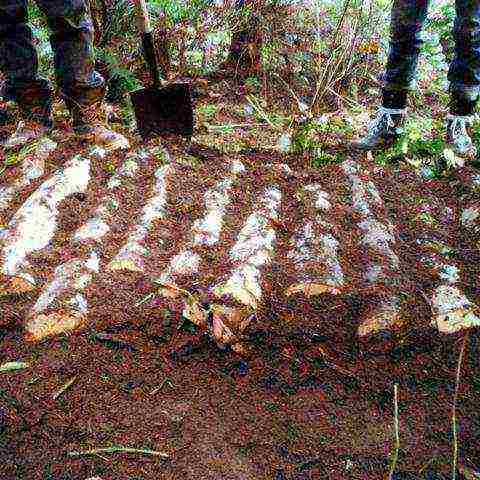
Method three
To grow mushrooms on the site, you need to collect mature mushroom caps. It is recommended to place them in a container and fill with water. The hats should stand for a few days. After that, the water from the container should be drained and filtered. The resulting infusion must be impregnated with pre-prepared pieces of wood or stumps. In addition, ripe mushroom caps can be laid out on the surface of the material. They can be removed after two days.
It is worth noting that this method is not suitable for everyone, since the germination process is very slow. The first harvest of honey agarics planted by a similar method can be obtained only by the end of the next season.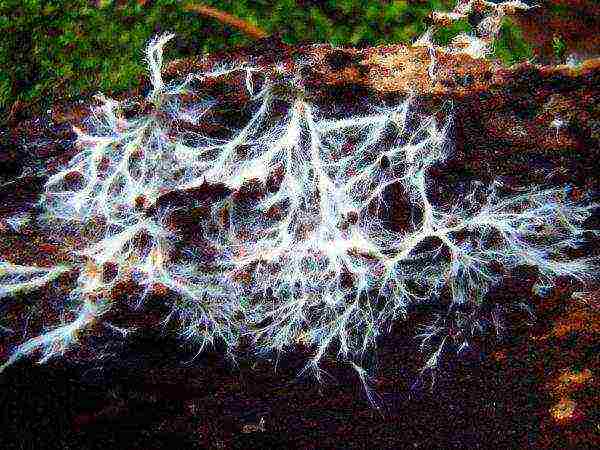
Germination of mycelium
There is also a less laborious way to germinate honey agaric. This will require not only rotten stumps or chocks, but also mycelium. At the same time, the growth of summer honey agaric proceeds more intensively. You can find mycelium in the forest. This should be done in early June. Only the area where the active growth of the mycelium is marked should be taken. As a rule, in such places you can see a large number of threads that have a cream or white tint. In addition, there should be a strong mushroom smell. Collect mycelium together with pieces of wood.
Such blanks must be placed in the notches on logs or stumps. So that the mycelium does not die, it is recommended to cover the landing site with shingles, moss or bark. For better germination, the stump or log should be covered with foil. This method allows you to get the first harvest of mushrooms by the beginning of the next season. It is best to infect wood with summer honeydew in the fall or early summer.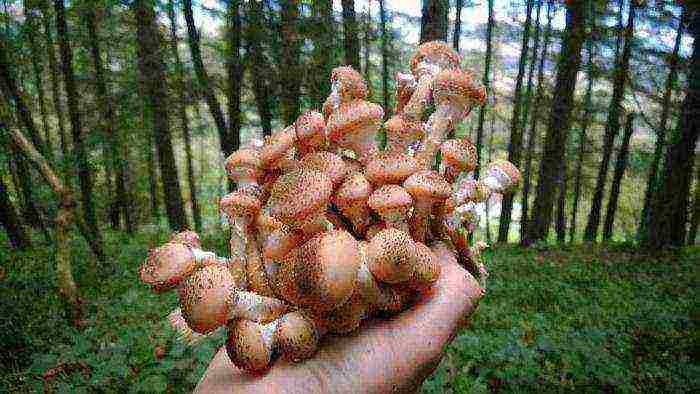
Growing features
The technology for growing honey agarics in the country is quite simple. However, there are some peculiarities. Such mushrooms should be covered with breathable material. If you wish, you can knock down a loose box of boards, agril, slab. Burlap or paper is also suitable for these purposes.
If the stumps remain from a freshly cut tree, then they do not need to be further processed. You can immediately start infecting them with honey agaric spores. If the upper part of the stump is dry, then it must be soaked. To do this, the wood is regularly watered for several days. Spores are planted only after the material has collected enough moisture.
The first mushrooms, if properly planted, should appear in June. They are harvested, as a rule, before September. However, it should be noted that there will be few mushrooms in the first year. The honey agaric yield largely depends on the degree of growth of the mycelium, the quality of the wood and weather conditions. In the second year, the number of mushrooms can increase by 4 times.
If mushrooms are planted in the garden, then it is worth choosing a darkened place where the sun's rays do not penetrate. If the stump is not in the shade, then it is recommended to cover it. For this, you can use hay or straw.
